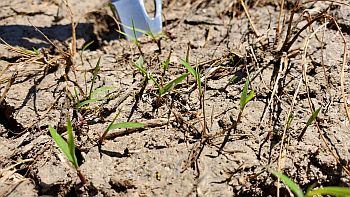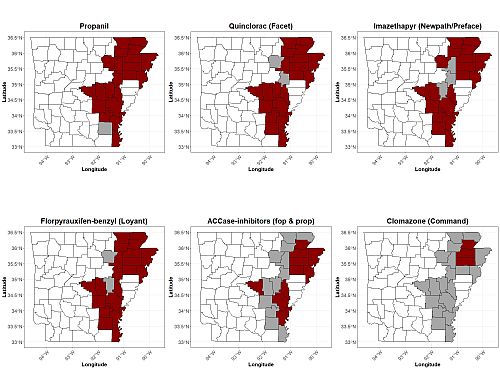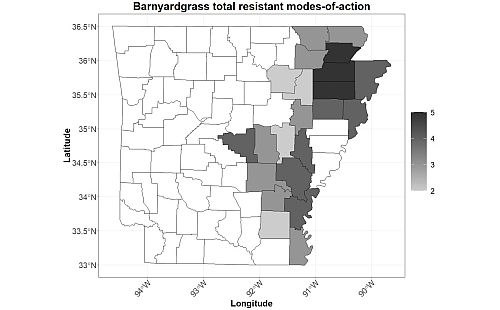Start clean, use residuals, and do not let weeds see the light of day
Start clean, use residuals, and don't let weeds see the light of day
By: Tommy Butts, Tom Barber, and Jason Norsworthy
Everything has officially greened up across the state (looks like I’m mowing our lawn soon), and rice is going in the ground. And although it’s a beautiful sight to see green lawns and trees, and Kelly tools, floats, and planters rolling, it also means weeds are in full swing.
Ryegrass has been more troublesome this spring to get controlled, especially with all of the wet weather delaying timely applications. It has popped up in several areas that have not had to deal with it to a large extent in previous years. Barnyardgrass is already well on its way to challenging our rice crop for the entire upcoming 2020 growing season (Figure 1). Barnyardgrass seed can germinate anytime when temperatures ranges from 55 to 104°F, and maximum germination occurs at temperatures of 68 to 86°F. Multiple herbicide-resistant populations of barnyardgrass are now common across the state (Figure 2 & 3), with resistance to 5 modes-of-action being identified in Arkansas: ALS-inhibitors (Newpath/Preface), DOXP-inhibitor (i.e. clomazone) (Command), ACCase-inhibitors (Fops and Props) (Clincher, Ricestar), Photosystem II inhibitors (propanil), and synthetic auxins (Facet, Loyant). This greatly limits herbicide options available to control barnyardgrass in rice. So, what’s our best option for getting a handle on weeds and start our rice crop off in the right direction? It’s in the title of this blog post, “Start clean, use residuals, and don’t let weeds see the light of day.”

Figure 1. Barnyardgrass seedlings emerging near Hoxie, AR on April 10th.
First and foremost, planting into a clean field is a must, so scout diligently. If we allow weeds to be up when we plant into the field, we’re automatically eliminating options that could help such as paraquat, glyphosate, or clethodim (Select Max). Fellow Extension Weed Scientist, Tom Barber, previously this year wrote a blog post about burndown options, especially to manage ryegrass and can be found here. It’s also necessary to observe plant-back restrictions on any potential burndown herbicides (e.g. 30 day plant-back to rice if clethodim is sprayed) to reduce the likelihood of crop injury occurring; check out MP-519, Row Crop Plant-Back Intervals for Common Herbicides.

The next item of business, especially for managing herbicide-resistant barnyardgrass, is to use preemergence (PRE) residual herbicides and overlap multiple applications. The best method of control for barnyardgrass in rice is to never let a seedling see the light of day. We recommend starting out with a PRE application of Command at a rate based on your specific soil type, 12.8 to 18 fl oz/acre for silt loam soils and 21 to 26 fl oz/acre for clay soils. These rates allow for a second application of Command to be applied EPOST to remain below the 34.1 fl oz/acre limit per year. A little bleaching on rice is normal and good because it indicates the herbicide is activated and working properly. A mixture of Prowl (2.1 pt/acre) + Bolero (4 pt/acre) should then be applied delayed PRE to overlap residual herbicides and use modes-of-action that barnyardgrass has not yet been confirmed resistant to in the state. These two herbicide applications should be the foundation of a barnyardgrass management plan. Building onto that foundation, other residual herbicide options can be added into the program. Facet may be added in PRE with Command or applied EPOST (2-3 leaf rice) at a rate based on your soil type (22-28 fl oz/acre on sands, 32 fl oz/acre on silt loams, and 43 fl oz/acre on clays). If using a Clearfield or FullPage rice system, 4-6 fl oz/acre of Newpath (Clearfield) or Preface (FullPage) may be mixed with Command PRE, EPOST (2-3 leaf rice), or at both timings to overlap the residual. Additionally, if broadleaves or rice flatsedge are concerns early-season, consider a Facet + Bolero mixture, or League (6.4 oz/acre), Grasp (2 oz/acre), or Gambit (2 oz/acre) (as long as the weeds are not ALS-inhibitor resistant) as residual herbicides that can help manage those weed species before they emerge. Although these programs are expensive up-front, the goal is to save a POST application later by not allowing barnyardgrass and other weed species to see the light of day, resulting in better overall weed control with reduced back-end costs. Residual PRE herbicides have a great long-term return on investment.
Please be sure to visit our website, https://www.uaex.uada.edu/weeds, for the latest U of A weed science information. If you ever have any questions, please don’t hesitate to get ahold of me at (501) 804-7314. Stay safe, good luck, and thanks for reading!
